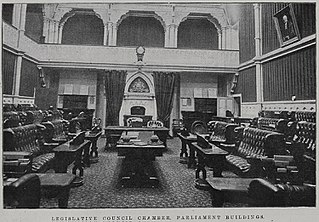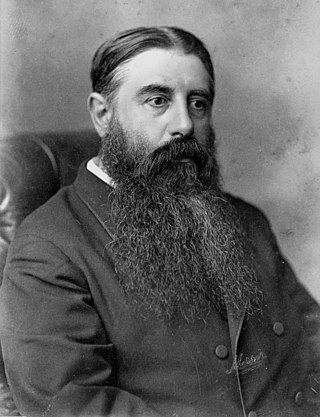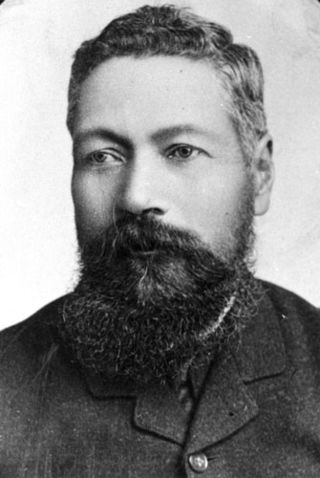Results
| Party | Candidate | Votes | % | ±% | |
|---|---|---|---|---|---|
| Independent | Tame Parata | 147 | 42.61 | ||
| Independent | Henare Paratini [3] | 104 | 30.14 | ||
| Independent | Hone Taare Tikao [4] | 94 | 27.25 | ||
| Majority | 43 | 12.46 | |||
| Turnout | 345 | ||||
The 1885 Southern Maori by-election was a by-election held on 10 June 1885 in the Southern Maori electorate during the 9th New Zealand Parliament.
The by-election was caused by the resignation of the incumbent, Hōri Kerei Taiaroa, when he was re-appointed to the Legislative Council.
Taiaroa had been appointed to the Legislative Council in February 1879, but in August 1880 was disqualified over a technicality, a cause of bitterness and resentment among Māori. When appointed by Sir George Grey, Taiaroa held (and continued to hold) a salaried (government) office, hence was not eligible to sit in the Council, despite having attended three sessions. [1]
The by-election was won by Tame Parata.
| Party | Candidate | Votes | % | ±% | |
|---|---|---|---|---|---|
| Independent | Tame Parata | 147 | 42.61 | ||
| Independent | Henare Paratini [3] | 104 | 30.14 | ||
| Independent | Hone Taare Tikao [4] | 94 | 27.25 | ||
| Majority | 43 | 12.46 | |||
| Turnout | 345 | ||||

The New Zealand Legislative Council was the upper house of the General Assembly of New Zealand between 1853 and 1951. An earlier arrangement of legislative councils for the colony and provinces existed from 1841 when New Zealand became a colony; it was reconstituted as the upper house of a bicameral legislature when New Zealand became self-governing in 1852, which came into effect in the following year.

The 24th New Zealand Parliament was a term of the New Zealand Parliament. It opened on 23 February 1932, following the 1931 election. It was dissolved on 1 November 1935 in preparation for the 1935 election. The 24th Parliament was extended by one year because the 1935 election was held later than anticipated due to the ongoing depression, similarly the 1919, and the 1943 elections were held two years late, having been postponed during World War I and World War II respectively.

The 1875–1876 New Zealand general election was held between 20 December 1875 and 29 January 1876 to elect a total of 88 MPs in 73 electorates to the 6th session of the New Zealand Parliament. The Māori vote was held on 4 and 15 January 1876. A total of 56,471 voters were registered.

The 1879 New Zealand general election was held between 28 August and 15 September 1879 to elect a total of 88 MPs to the 7th session of the New Zealand Parliament. The Māori vote was held on 8 September. A total of 82,271 (66.5%) European voters turned out to vote, plus 14,553 Māori voters. Following the election, John Hall formed a new government.

The 1890 New Zealand general election was one of New Zealand's most significant. It marked the beginning of party politics in New Zealand with the formation of the Liberal Government, which was to enact major welfare, labour and electoral reforms, including giving the vote to women.

The 1896 New Zealand general election was held on Wednesday, 4 December in the general electorates, and on Thursday, 19 December in the Māori electorates to elect a total of 74 MPs to the 13th session of the New Zealand Parliament. A total number of 337,024 (76.1%) voters turned out to vote.

The 1922 New Zealand general election was held on Monday, 6 December in the Māori electorates, and on Tuesday, 7 December in the general electorates to elect a total of 80 MPs to the 21st session of the New Zealand Parliament. A total number of 700,111 (87.7%) voters turned out to vote. In one seat there was only one candidate.
Southern Maori was one of New Zealand's four original parliamentary Māori electorates established in 1868, along with Eastern Maori, Western Maori and Eastern Maori. In 1996, with the introduction of MMP, the Maori electorates were updated, and Southern Maori was replaced with the Te Tai Tonga and Te Puku O Te Whenua electorates.
Western Maori was one of New Zealand's four original parliamentary Māori electorates established in 1868, along with Northern Maori, Eastern Maori and Southern Maori. In 1996, with the introduction of MMP, the Maori electorates were updated, and Western Maori was replaced with the Te Tai Hauāuru and Te Puku O Te Whenua electorates.

Tame Parata, also known as Thomas Pratt, was a Māori and a Liberal Party Member of Parliament in New Zealand.

Hōri Kerei Taiaroa, also known as Huriwhenua, was a Māori member of the New Zealand parliament and the paramount chief of the southern iwi of Ngāi Tahu. The son of Ngāi Tahu leader Te Mātenga Taiaroa and Mawera Taiaroa, he was born at Ōtākou on the Otago Peninsula in the 1830s or early 1840s.
Christchurch was a parliamentary electorate in Christchurch, New Zealand. It existed three times. Originally it was the Town of Christchurch from 1853 to 1860. From the 1860–1861 election to the 1871 election, it existed as City of Christchurch. It then existed from the 1875–1876 election until the 1881 election. The last period was from the 1890 election to the 1905 election. Since the 1946 election, a similarly named electorate called Christchurch Central has been in existence.

Edward Richardson was a New Zealand civil and mechanical engineer, and Member of Parliament. Born in England, he emigrated to Australia and continued there as a railway engineer. Having become a partner in a contracting firm, a large project caused him to move to Christchurch in New Zealand, in which country he lived for the rest of his life.

Gerard George Fitzgerald was a 19th-century Member of Parliament in New Zealand. Like his brother James FitzGerald, he was a journalist of considerable ability, and co-founded The Southland Times in 1862. For the last 19 years of his life, he was editor of The Timaru Herald.

Rino Tirikatene is a New Zealand Labour Party politician and a former member of the House of Representatives. He comes from a family with a strong political history.
Hōne Taare Tīkao was a New Zealand tribal leader, scholar and politician. Of Māori descent, he identified with the Ngāi Tahu iwi. He was born on Banks Peninsula, New Zealand in about 1850.
The Oamaru by-election 1885 was a by-election held in the Oamaru electorate during the 9th New Zealand Parliament, on 20 May 1885. The by-election was caused by the resignation of the incumbent, Samuel Shrimski, who was appointed to the Legislative Council, and was won by Thomas William Hislop.
James Melville Balfour was a Scottish-born New Zealand marine engineer. He is best remembered for the network of lighthouses that he designed. Balfour was a highly energetic man, who despite drowning after only six years in the country, has left a list of projects either designed or constructed by him. He was initially employed by the Otago Provincial Council before his appointment by the Government of New Zealand as the colonial marine engineer.
The 1879 Southern Maori by-election was a by-election held on 7 July 1879 in the Southern Maori electorate during the 6th New Zealand Parliament.
The 1881 Southern Maori by-election was a by-election held on 1 March 1881 in the Southern Maori electorate during the 7th New Zealand Parliament.